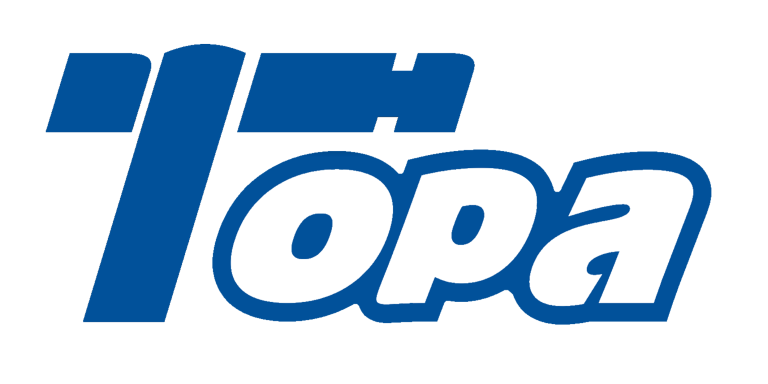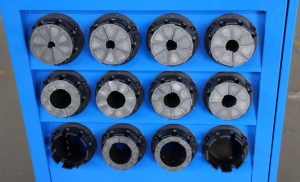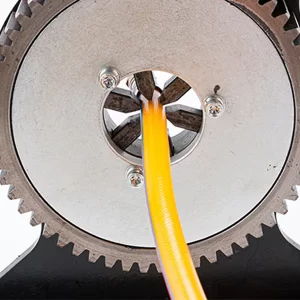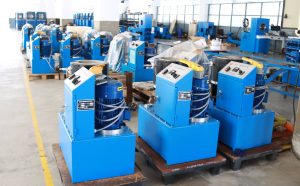Hydraulic hose failures create downtime, lost contracts, and a mountain of safety paperwork for every maintenance supervisor or purchasing manager. Ready for the good part? A reliable hydraulic hose crimper eliminates those headaches by letting your crew fabricate assemblies on-site, under thirty minutes, without chasing distant vendors. This article walks you through every angle—definition, selection, usage, upkeep, and buying tips—so your team moves faster, saves cash, and wins fresh orders with confidence. Expect step-by-step explanations, real-world shop anecdotes, and crisp tables that compare pressure ratings, feature sets, and budget tiers. Let’s dive into the nuts and bolts right now.
1. What Exactly Is a Hydraulic Hose Crimper?
Definition of a Hydraulic Hose Crimper
A hydraulic hose crimper compresses a metal sleeve, called a ferrule, around a hose end fitting. The tool’s dies close radially, biting into the outer rubber and gripping the inner wire reinforcement so pressure spikes never blow fittings off. But here’s the kicker… unlike generic presses, a hydraulic hose crimper applies perfectly calculated force every cycle, giving repeatable, leak-free results whether you build one test sample or a thousand production assemblies.
Primary Uses in Industry
Maintenance shops keep production lines alive by fabricating replacement lines on location. Fleet operators avoid roadside failures by stocking bulk hose and crimping assemblies before a long haul. OEM factories speed up model changeovers because in-house crimping shortens supply chains. This is where it gets interesting… specialized sectors—mining, offshore drilling, amusement rides—run custom lengths that never appear in catalogs, yet a portable crimper lets engineers match odd shapes within hours.
Basic Components Explained
Core elements include a hydraulic power unit, interchangeable die sets, a holding nest, and an electronic micrometer or mechanical stop ring guaranteeing correct closure diameter. Smaller bench models use a simple hand pump, while heavy production systems harness electric-over-hydraulic power packs for rapid cycling. What’s the real story? Smart sensors now record each stroke, creating digital certificates that auditors crave during ISO compliance reviews.
2. Why Do You Need a Hydraulic Hose Crimper?
Importance in Industrial Settings
Plant managers face rising labor costs, shrinking maintenance windows, and stricter safety codes. Outsourced hose fabrication forces overnight shipping plus idle machinery—profit evaporates. Owning a crimper cuts wait time from days down to minutes, slashes emergency freight bills, and keeps warranty liability under your roof. Hold on—there’s more… customers respect suppliers who deliver assembled lines the same afternoon they call, cementing long-term contracts.
Common Applications and Industries
Construction fleets, forestry harvesters, and agricultural sprayers tear hoses daily; a yard-mounted crimper keeps harvest on schedule. Aviation ground-support carts rely on custom Teflon® hoses that must be crimped under sterile conditions inside hangars. Steel mills with molten splash zones need stainless fittings never stocked by local shops, so maintenance welders clamp them in-house. Municipal snow-removal crews crimp cold-weather elastomer hoses at two a.m. during storms, avoiding equipment stranded on icy bridges.
Consequences of Incorrect Hose Crimping
Undersized crimps leak hydraulic oil at 5,000 psi, leading to environmental penalties. Oversized crimps crush wire braid and burst under pulsation, injuring operators. Ready for the jaw-drop? A single quart of hydraulic fluid can contaminate 240,000 gallons of water, triggering cleanup bills larger than the machine’s purchase price. Proper crimper ownership plus calibrated gauges avert that nightmare.
| Key Benefit | In-House Crimping Result | Outsourced Fabrication Result |
|---|---|---|
| Downtime per failure | <1 hour | 24–72 hours |
| Emergency freight cost | None | $150–$600 per shipment |
| QC traceability | Instant digital log | Third-party paperwork |
3. How Does a Hydraulic Hose Crimper Work?
Step-by-Step Operation Guide
Operators cut hose square, clean residue, slide ferrule over cover, insert fitting, and place assembly into the crimper nest. Touchscreen or dial selects hose spec. Dies close hydraulically, squeezing ferrule until micrometer shows final diameter. A go/no-go ring verifies accuracy. Here’s the deal… modern machines store hundreds of presets, so new staff members press one button and get flawless crimps their first shift.
Role of Hydraulic Pressure in Crimping
A compact power unit pumps fluid at 3,000 psi into a piston that drives segmented dies. Pressure multiplies across piston area, creating up to 400 kN radial force. That energy reforms the soft ferrule, not the hardened fitting stem, so metal flows into serrations and locks everything tight.
Key Mechanisms Explained Clearly
Return springs or twin-acting cylinders reopen dies automatically, boosting throughput. Inductive sensors detect ferrule presence, preventing dry-cycle damage. Integrated lube reservoirs cut friction, extending die life beyond 50,000 strokes. What’s the secret sauce? Variable displacement pumps adjust flow on demand, shrinking cycle time without overheating seals.
4. What Types of Hydraulic Hose Crimpers Are Available?
Manual Hose Crimpers
Hand pump units weigh under 40 kg and suit field repairs. They accept hose diameters up to 1-inch, ideal for farmers or mobile service trucks. A rugged steel frame and bolt-on dies minimize downtime.
Electric Hose Crimpers
Powered by 230 V single-phase or 415 V three-phase motors, these shop models handle 2-inch four-wire hoses all day. Touchscreen menus, automatic lubrication, and barcode scanners speed production lines. This is where it gets interesting… optional IoT modules email cycle counts straight to service departments for predictive maintenance.
Portable Hose Crimpers
Lightweight battery-powered presses ride along in mining cabs or marine decks where cables pose hazards. Quick-change lithium packs deliver 150 cycles per charge, plenty for emergency tasks.
| Crimper Style | Max Hose ID | Cycle Time | Typical Location |
|---|---|---|---|
| Manual | 1 in. | 90 s | Roadside service |
| Electric | 2 in. | 15 s | OEM assembly cell |
| Battery | 1¼ in. | 30 s | Offshore platform |
5. Which Hydraulic Hose Crimper Is Right for Your Business?
Assessing Your Crimping Needs
Track monthly hose usage, diameter range, and peak rush orders. A quarry moving 60 hoses monthly at 1½ inch ID needs a mid-tier electric unit. A packaging plant running two ⅜-inch lines per week survives on a compact bench tool. But here’s the kicker… growth projections matter: buy fifty percent above today’s tonnage so capital outlay lasts a decade.
Considering Volume and Frequency of Usage
Continuous duty cycles demand oil coolers, automatic die greasing, and touchless guards. Intermittent shops choose air-over-hydraulic pumps for silence. Leasing options help seasonal businesses conserve cash while gaining uptime during harvest.
Budget-Friendly vs. Premium Models
Entry kits start near $2,500, include eight die sets, and crimp up to 1-inch two-wire. Premium CNC presses climb beyond $35,000, featuring servo drives and cloud connectivity. Payback arrives within nine months for fleets burning through hoses daily. Ready for the good part? Many vendors apply rental fees toward purchase, giving you a test drive before full commitment.
6. What Are the Main Features of a Quality Hose Crimper?
Durability and Construction Materials
Heat-treated alloy steel dies withstand repeated high-force cycles without galling. Nickel-plated pistons resist corrosion from glycol-based fluids. Powder-coated frames shrug off shop chemicals.
Precision and Accuracy in Crimping
Digital calipers built into ram assemblies control closure diameter within ±0.05 mm. Memory chips inside die cassettes store calibration data, eliminating guesswork when swapping sets. You might be wondering… how manufacturers hit such tight tolerances? Robotic machining centers grind every die half simultaneously, keeping variances microscopic.
Safety Features and Certifications
CE and UL badges guarantee guarded pinch points plus dual-hand actuation. Transparent polycarbonate shields let operators monitor ferrule seating while blocking flying debris. E-stop buttons connect directly with redundant relays, stopping motion faster than human blink time.
| Feature | Benefit | Typical Spec |
|---|---|---|
| Die Calibration Memory | Faster changeovers | <10 s switch |
| Ram Accuracy | Leak-free joints | ±0.05 mm |
| Safety Guard Material | Impact resistance | Polycarbonate |
7. How Do You Properly Use a Hydraulic Hose Crimper?
Preparation and Initial Setup
Inspect hose cover for cuts, flush interior with solvent, and mark insertion depth on fitting stem. Clamp crimper to level bench, bleed hydraulic circuit, and verify oil level. But here’s the kicker… skipping a five-minute inspection often triggers catastrophic leaks under warranty audits.
Selecting the Right Dies and Fittings
Match die code with hose series printed on layline. Consult manufacturer charts for target crimp OD. Slide correct die halves into cage, making sure notches align with spring pins. Choose fittings sharing metallurgy with ferrule to prevent galvanic corrosion.
Safe Operation Guidelines
Stand clear of die split line, wear ANSI-approved face shield, and keep fingers outside guard. Energize pump, monitor gauge, release at preset OD. Use ring gauge after each assembly; if ring fails, record batch number for traceability. Ready for the good part? QR stickers on modern gauges upload measurements direct into ERP systems, automating certificate generation for every assembly.
8. What Common Mistakes Occur During Hose Crimping?
Improper Die Selection
Using oversize dies leaves gaps under ferrule, leading pressurized fluid jets. Undersize dies shear wire reinforcement at bend points. Maintain laminated reference cards next to machine.
Over-Crimping or Under-Crimping Issues
Over-crimping distorts fitting bore, blocking flow and heating oil. Under-crimping allows micro-movements that saw hose cover over time. What’s the real story? Both errors often trace back to wrong micrometer settings after night shift cleaning.
Inadequate Maintenance Practices
Dry dies seize, scratching ferrules and scattering contaminants into hydraulic systems. Failing to replace cracked spring cages risks die fragments exploding at high velocity. Daily wipe-down with lint-free cloth plus weekly grease film extends lifespan fivefold.
| Error Type | Field Symptom | Preventive Action |
|---|---|---|
| Over-crimp | Hose bursts at fitting | Verify stop ring thickness |
| Under-crimp | Slow drips | Check ring gauge every run |
| Wrong die | Oval ferrule shape | Color-code die racks |
9. How Can You Maintain Your Hydraulic Hose Crimper?
Daily Maintenance Routine
Clean die cavity, drain condensation from air line, and top hydraulic reservoir if sight glass dips below half. But here’s the kicker… those two minutes delay rust buildup that might seize pistons after winter shutdown.
Long-Term Care and Storage
Schedule quarterly oil analysis, checking particle count and water ingress. Replace high-pressure hoses on power unit every two years regardless of appearance. Store spare dies in foam-lined trays coated with vapor phase inhibitor bags.
Troubleshooting Basic Problems
Slow closing speed? Inspect pump inlet strainer for sludge. Uneven crimp diameter? Verify die halves match letter code. Unexpected noise? Examine linkage bushings for galling. Keep spare O-ring kits and rod wipers in tool cabinet for lightning-fast swaps.
10. What Are the Benefits of Owning a Hydraulic Hose Crimper?
Improved Efficiency and Productivity
Operators fabricate custom hoses within ten minutes, reducing repair backlog. Assemblers run prototypes without waiting for vendor lead times, accelerating product launches.
Cost Savings from In-House Crimping
Buying bulk hose reels cuts per-foot price nearly forty percent compared with pre-made lines. Eliminating rush courier fees saves thousands monthly across large fleets. Ready for the good part? Captured savings pay back equipment investment well before depreciation ends.
Reduced Downtime and Quick Repairs
A stuck excavator cylinder at remote quarry no longer idles crew for two days. Portable crimper in service truck crafts replacement line on location, keeping blast schedule intact.
| Metric | Outsourced | In-House |
|---|---|---|
| Average cost per 1-inch × 3 ft hose | $85 | $28 |
| Labor time per assembly | N/A | 10 min |
| Annual downtime cost (50 failures) | $45 k | <$3 k |
11. What Safety Tips Should You Follow When Using Hose Crimpers?
Proper Protective Gear (PPE)
Face shield, cut-resistant gloves, and steel-toe footwear keep operators safe from metal shards and dropped fittings. But here’s the kicker… safety glasses alone cannot stop high-velocity ferrule fragments, invest in full-coverage shields.
Safe Work Environment Guidelines
Anchor crimper on sturdy bench, maintain clear floor space, and keep spill kit within arm’s reach. Post laminated emergency stop flowchart above machine.
Handling Hydraulic Fluid Correctly
Use drip pans when disconnecting test bench hoses, label waste drums, and consult local disposal regulations. Oil mist inhalation hazards require proper ventilation fans.
12. How Do You Select the Right Hose and Fittings for Crimping?
Matching Hose Types and Applications
Thermoplastic hoses excel in low-temperature settings; spiral-wire rubber handles shock pulses on excavators. Stainless braid PTFE lines suit food plant washdown zones.
Understanding Hose Diameter and Pressure Ratings
Check working pressure printed on layline and maintain four-to-one safety factor against peak spikes. This is where it gets interesting… some applications meet flow target with smaller hose if velocity stays under recommended threshold, cutting bend radius and weight.
Choosing Compatible Fittings
Carbon steel fittings pair with rubber hoses for cost savings, while 316 stainless prevents corrosion in salt fog. Always select ferrules matching hose series; mixed brands void warranties.
13. What Should You Consider Before Buying a Hydraulic Hose Crimper?
Supplier Reputation and Support
Look for vendors with regional service technicians, spare parts stock, and training programs. You might be wondering… why not chase the absolute lowest quote? Hidden downtime from slow parts shipping erodes savings quickly.
Available Warranty and After-Sales Service
Minimum two-year warranty on power unit and one-year on dies shows confidence in build quality. Remote firmware updates plus phone support reduce technician travel bills.
Evaluating Customer Reviews and Recommendations
Call peers in your industry, visit trade forums, and request sample crimps. Inspect ferrule finish, measure OD variance, and ask operators about user interface quirks.
14. How Much Does a Hydraulic Hose Crimper Cost?
Average Pricing Overview
Bench models start near $2,500; industrial four-inch presses reach six figures. Mid-range 2-inch machines with touchscreen average $12,000.
Factors Influencing Costs
Die inventory size, automatic lubrication, and IoT connectivity raise upfront investment. Import tariffs, exchange rates, and freight charges also sway final bill. But here’s the kicker… buying during fiscal-year clearance sales can shave fifteen percent off list price.
Cost-Effective Alternatives for Smaller Businesses
Used units with verified calibration certificates deliver performance at half price. Rental plans cover short-term construction projects without locking capital.
15. Where Can You Buy a Reliable Hydraulic Hose Crimper?
Online Marketplaces vs. Local Suppliers
E-commerce sites list thousands of models; lead times vary, and after-sale service often lags. Local distributors ship faster, lend demo units, and provide on-site training.
Trusted Brands and Recommended Suppliers
Reputable names include Finn-Power, Uniflex, and Gates. Request factory references and CE certificates before paying deposits. This is where it gets interesting… some OEMs brand-label identical machines; comparing specs rather than decals uncovers hidden bargains.
Tips for Safe Online Purchases
Use escrow services, verify tax IDs, and insist on video inspection before shipment. Track pallet weight against invoice; missing die sets show instantly on scale.
Conclusion
Hydraulic hose crimpers transform reactive maintenance into proactive uptime by handing control of hose assembly back to your shop. Ready for the good part? After learning definitions, mechanisms, feature checklists, safety practices, and buying strategies, you can now shortlist machines that match volume, pressure classes, and budget tiers. Faster repairs, lower hose costs, and airtight quality documentation await teams that act today. Contact your preferred distributor, schedule a demo, and watch downtime vanish.
FAQ
Q1: What is a hydraulic hose crimper?
A hydraulic hose crimper compresses a metal ferrule around a hose fitting, forming a high-pressure seal that withstands demanding industrial cycles.
Q2: How does a hydraulic hose crimper work?
A hydraulic piston drives segmented dies inward, squeezing the ferrule uniformly until preset diameter readings confirm a secure joint.
Q3: Can I use any hose fitting with my crimper?
No, fittings must match hose brand, wire layer count, and size chart provided by your crimper manufacturer for safe performance.
Q4: Do hydraulic hose crimpers require special maintenance?
Yes, daily cleaning, weekly lubrication, and periodic oil analysis preserve accuracy and extend machine life dramatically.
Q5: Are portable hydraulic hose crimpers effective?
Portable models handle moderate diameters successfully in field repairs, though high-volume production still favors stationary electric presses.




